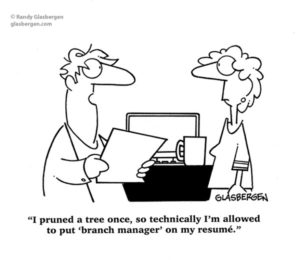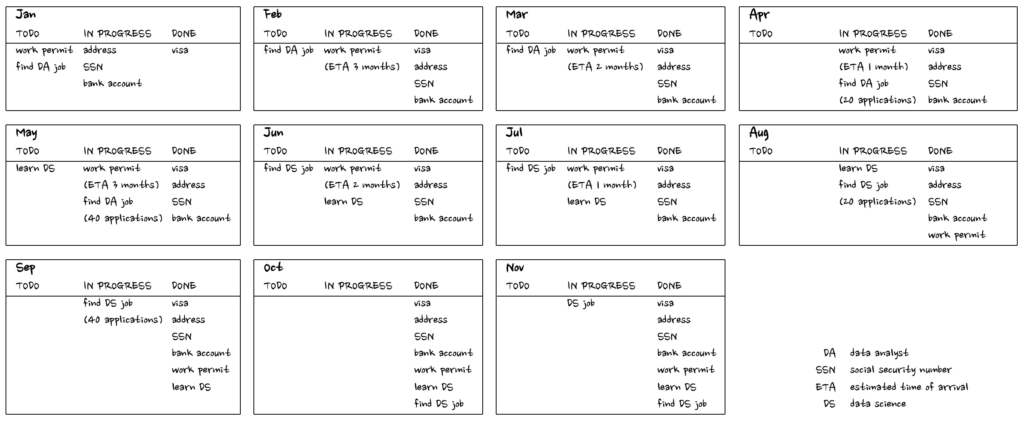To survive here, you have to appear positive. Smiling a lot helps but it is not enough. There is nothing positive in saying one is unemployed which is why a lot of people call themselves funemployed. Also, one cannot just be looking for a job, that sounds desperate. One has to be landing his or her dream job. No kidding! How did that work for me?

There is nothing exciting or interesting about looking for a job so I am not sure why people kept asking me about it. Over the time I developed three hypotheses which I now present, ordered by how likely they are (from almost certainly true to almost impossible).
- People think it sucks and they enjoy hearing your life it worse than theirs.
- People think it is exciting and want to hear about it.
- People actually care about you and wish you to land your dream job.
I quit my last job at the end of December which made my funemployment exactly 10 months long. Here is a quick recap of what was going on with my job search:
I used to work as data analyst in London and I assumed I would find similar position relatively easily in Seattle. Wrong! I started by updating my online profile on all relevant networks: LinkedIn, Hired, Dice, Indeed, Glassdoor, AngelList, you name it. Of course I also actively searched for jobs. People and machines noticed quickly and started acting accordingly, trying to offer me the best position. Comparing human and machine efforts, I am not sure who did a better job.
- Machines (automatically generated ad): “Searching for Data Analyst Jobs? Earn Money Driving with Lyft!”
- Humans (email from a recruiter): “I came across your profile and was glad to learn that you would be a good match for one of our openings in Cisco, TX for positions of Logistics Coordinator.”
I applied for roughly 40 data analyst positions online but I received very few responses, mostly variations on “we have decided to proceed with other candidates”. I also noticed that some data analyst job descriptions mentioned skills like modeling and forecasting. It sounded like a good idea to obtain those skills that are usually taught under data science curriculum. Digging deeper into the whole data analyst versus data scientist differentiation, I realized that the data science path may not be that far from me. Plus the job market numbers suggested that being an entry level data scientist might be better idea than being a senior data analyst.
- Data analyst Seattle area average salary: $64,960 per Glassdoor, $66,000 per Indeed.
- Data scientist Seattle area average salary: $118,593 per Glassdoor, $86,000 per Indeed.
The joke says that “Data scientist is data analyst who lives in California.” I see how it could have been the understanding a few years ago. Nowadays data scientist could be described as someone who can do data analysis (totally me), programming (kind of me) and some statistics, including experiment design (not me at all). Still waiting for my work permit which was delayed by another 3 months, I decided to sign up for data science program at Galvanize and spent 12 weeks filling in the gaps in my knowledge.
There were 19 students in my data science class, coming from various backgrounds (software engineers, structural engineers, actuaries, analysts). Some of them supposedly decided for data science career after they read that it was the sexiest job of the 21st century. Our day would begin at 8:30 with a 30-minute test. The morning would be filled with a lecture followed by individual programming exercise. Faster people would get an hour break for lunch; I was not fast enough most of the time. In the afternoon there was another lecture followed by pair programming exercise. We were supposed to be finished by 5pm which rarely happened. When it did, there was still optional reading for the evening. The program was intense. We were expected to pick up git in a day, SQL in a few days, Python in a week. That was the easier (easier does not mean easy) part of it for me, difficult for people without computer science background. Then there was probability, statistics, distributions, experimental design and AB testing where I was totally lost. It was definitely more than was covered in one semester of statistics at my university. Here is the curriculum overview; it is worth noting that we coded most of the algorithms from scratch before we were allowed to use scikit-learn and other libraries.
- Statistical Inference, Bayesian Methods, A/B Testing, Multi-Armed Bandit
- Supervised Machine Learning (Regression, Decision Trees), Ensemble Methods (Random Forests, Boosting)
- Data Visualization, Regularization, Gradient Descent
- Unsupervised Machine Learning (Clustering, Topic Modeling), Natural Language Processing
Last two weeks of the program were dedicated to our capstone projects. I created models to predict priority and severity of reported bugs (using Mozilla bug reports dataset). That part worked really well at the end. I also tried to detect duplicates which turned out to be much more complicated and not achievable in the given timeframe. All code is on GitHub and for a while I will also keep up the website bugtriaging.com that I used for presentation. By the way, there was exactly one day in the program when we were taught about Flask and Bootstrap before we were expected to use it for our projects.
After finishing our capstone projects, we were officially proclaimed to be data scientists and started the job hunt. I mean landing the dream job. Whatever. We got our LinkedIn profiles and resumes reviewed and got advice on networking, interviewing and salary negotiations. We were also explained the concept of informational interviews which is something I never heard of before. Here is the quick how to
- Find a company, preferably one that you like that is hiring (or might be eventually hiring) data scientists.
- Find a data scientist who works there. It helps if you know someone who knows this person (to be introduced) but you are allowed to just stalk random people on LinkedIn.
- Invite the data scientist for coffee.
- If they accept, be happy. Also ask them “smart” questions about the company, interview process and the data science job in general.
- Hope that the data scientist will offer to refer you or become somehow useful at the end.

Recruiters sometimes cannot speak openly about what companies the are hiring for. Left column – what recruiters can tell you. Right column – companies in Seattle area. Can you match those?
Super weird and creepy, right? Nevertheless, I conducted 8 informational interviews – I got introduction through Galvanize 5 times (past students who became real data scientists, friends of my classmates, connections of the teachers), I used my existing contacts in 2 occasions and I managed to ask a complete stranger once. Actually, I asked a complete stranger four times but three of them ignored me. As much as I hate the concept of networking, it turned out to be the most efficient thing to do. One of the companies thought I could become a QA engineer; I refused as it was not what I was looking for but hey, at least they were talking to me. Another company seemed genuinely interested in my capstone project; they said they will be hiring more people in November and I expect to hear from them again in a few weeks. Two companies liked me enough to interview me and offer me a job; I accepted one of them.
Yeah, easy just like that. When I manage to forget about those 80 unfruitful job applications and all the days when I questioned meaning of my life, I might be able to call this period a funemployment. My real employment starts next week, October 31, and I am super excited and super nervous at the same time. Wish me good luck and stay tuned for more news. What? You say you want to know more? Well, I guess I can tell you that I will work as data scientist and it will take me less than 20 minutes to walk to the office. Pretty sweet…
